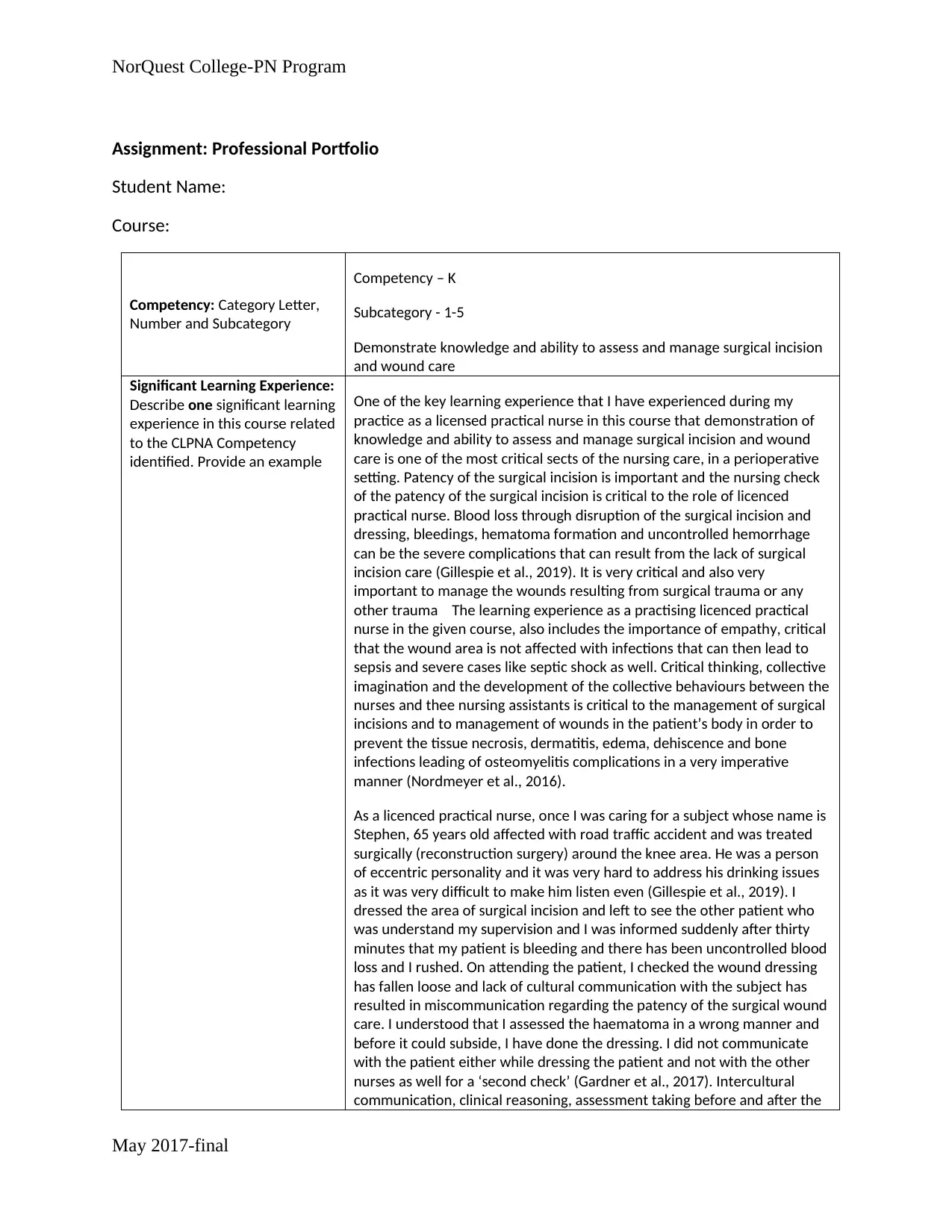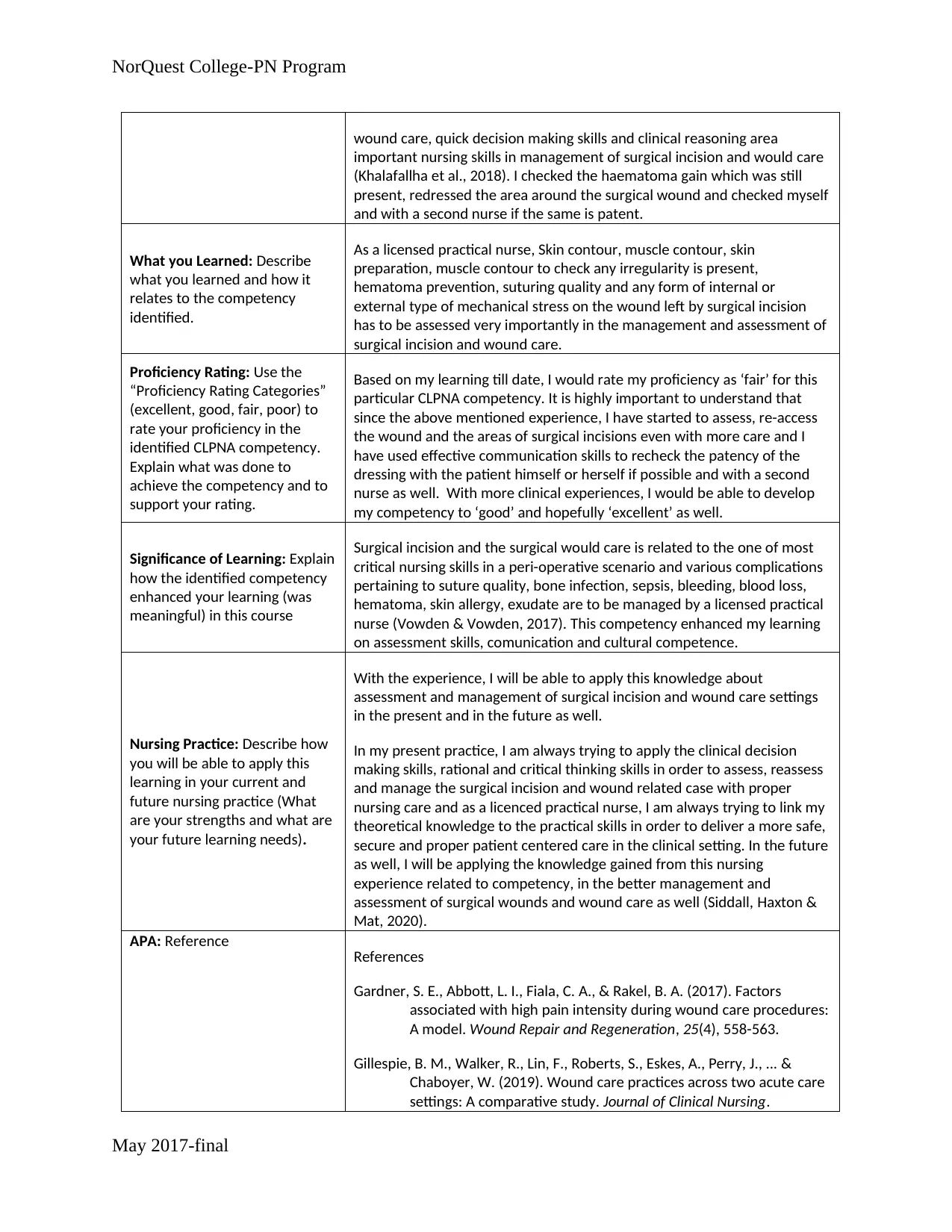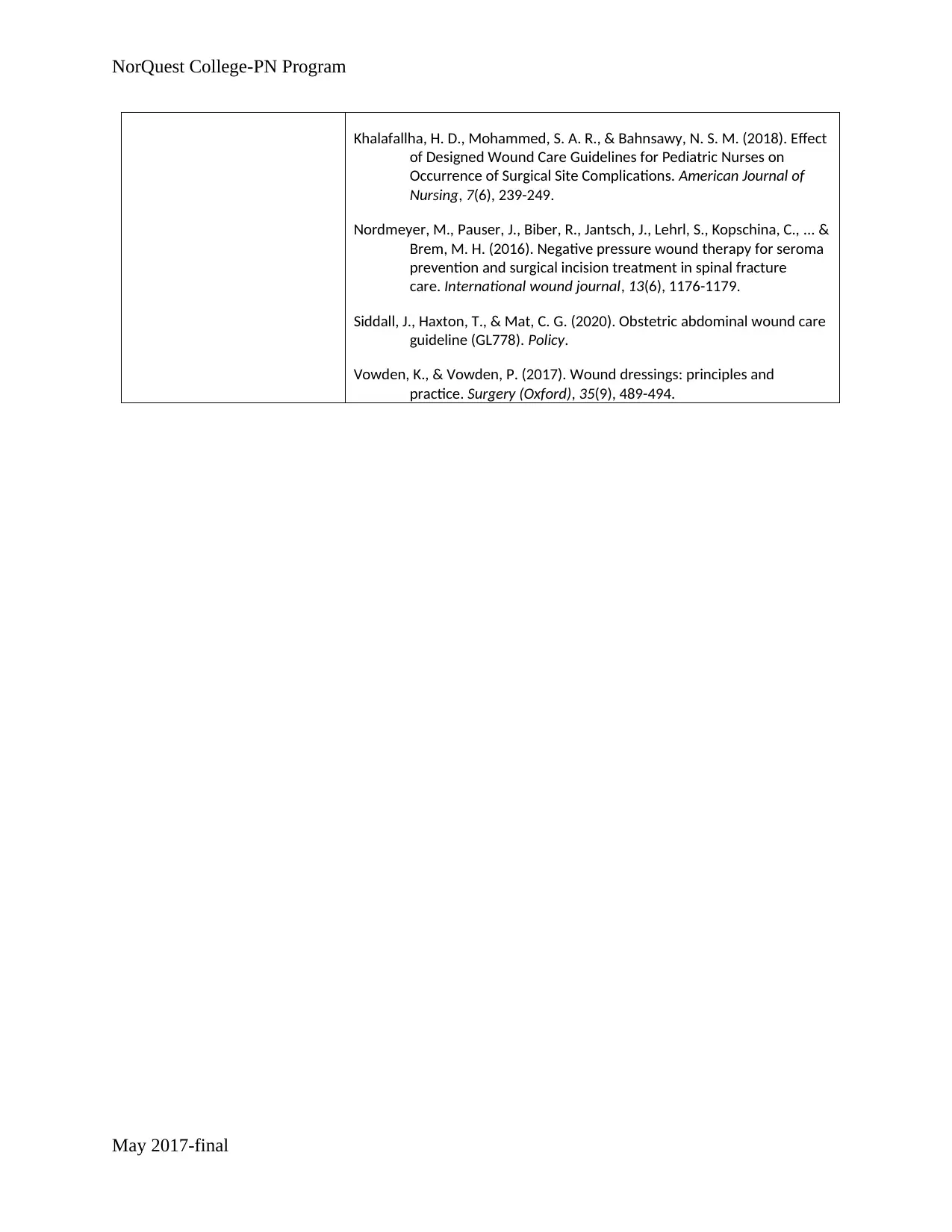Professional Portfolio Assignment: Wound Care and Incision Management
VerifiedAdded on 2022/08/19
|3
|1401
|9
Project
AI Summary
This assignment presents a student's professional portfolio from the NorQuest College PN Program, focusing on the CLPNA competency of demonstrating knowledge and ability to assess and manage surgical incisions and wound care. The portfolio details a significant learning experience involving a patient with a surgical incision, highlighting the importance of proper assessment, communication, and timely intervention to prevent complications like bleeding and hematoma. The student reflects on what was learned, emphasizing the need for meticulous skin and muscle contour assessment, hematoma prevention, and effective communication. The student rates their proficiency as 'fair,' citing the experience as a catalyst for improved practice and a commitment to continuous learning. The portfolio also discusses the significance of the competency in peri-operative scenarios and its application in current and future nursing practice, emphasizing the integration of theoretical knowledge with practical skills for delivering safe, patient-centered care. The assignment includes APA-formatted references to support the student's learning and experiences.

NorQuest College-PN Program
Assignment: Professional Portfolio
Student Name:
Course:
Competency: Category Letter,
Number and Subcategory
Competency – K
Subcategory - 1-5
Demonstrate knowledge and ability to assess and manage surgical incision
and wound care
Significant Learning Experience:
Describe one significant learning
experience in this course related
to the CLPNA Competency
identified. Provide an example
One of the key learning experience that I have experienced during my
practice as a licensed practical nurse in this course that demonstration of
knowledge and ability to assess and manage surgical incision and wound
care is one of the most critical sects of the nursing care, in a perioperative
setting. Patency of the surgical incision is important and the nursing check
of the patency of the surgical incision is critical to the role of licenced
practical nurse. Blood loss through disruption of the surgical incision and
dressing, bleedings, hematoma formation and uncontrolled hemorrhage
can be the severe complications that can result from the lack of surgical
incision care (Gillespie et al., 2019). It is very critical and also very
important to manage the wounds resulting from surgical trauma or any
other trauma The learning experience as a practising licenced practical
nurse in the given course, also includes the importance of empathy, critical
that the wound area is not affected with infections that can then lead to
sepsis and severe cases like septic shock as well. Critical thinking, collective
imagination and the development of the collective behaviours between the
nurses and thee nursing assistants is critical to the management of surgical
incisions and to management of wounds in the patient’s body in order to
prevent the tissue necrosis, dermatitis, edema, dehiscence and bone
infections leading of osteomyelitis complications in a very imperative
manner (Nordmeyer et al., 2016).
As a licenced practical nurse, once I was caring for a subject whose name is
Stephen, 65 years old affected with road traffic accident and was treated
surgically (reconstruction surgery) around the knee area. He was a person
of eccentric personality and it was very hard to address his drinking issues
as it was very difficult to make him listen even (Gillespie et al., 2019). I
dressed the area of surgical incision and left to see the other patient who
was understand my supervision and I was informed suddenly after thirty
minutes that my patient is bleeding and there has been uncontrolled blood
loss and I rushed. On attending the patient, I checked the wound dressing
has fallen loose and lack of cultural communication with the subject has
resulted in miscommunication regarding the patency of the surgical wound
care. I understood that I assessed the haematoma in a wrong manner and
before it could subside, I have done the dressing. I did not communicate
with the patient either while dressing the patient and not with the other
nurses as well for a ‘second check’ (Gardner et al., 2017). Intercultural
communication, clinical reasoning, assessment taking before and after the
May 2017-final
Assignment: Professional Portfolio
Student Name:
Course:
Competency: Category Letter,
Number and Subcategory
Competency – K
Subcategory - 1-5
Demonstrate knowledge and ability to assess and manage surgical incision
and wound care
Significant Learning Experience:
Describe one significant learning
experience in this course related
to the CLPNA Competency
identified. Provide an example
One of the key learning experience that I have experienced during my
practice as a licensed practical nurse in this course that demonstration of
knowledge and ability to assess and manage surgical incision and wound
care is one of the most critical sects of the nursing care, in a perioperative
setting. Patency of the surgical incision is important and the nursing check
of the patency of the surgical incision is critical to the role of licenced
practical nurse. Blood loss through disruption of the surgical incision and
dressing, bleedings, hematoma formation and uncontrolled hemorrhage
can be the severe complications that can result from the lack of surgical
incision care (Gillespie et al., 2019). It is very critical and also very
important to manage the wounds resulting from surgical trauma or any
other trauma The learning experience as a practising licenced practical
nurse in the given course, also includes the importance of empathy, critical
that the wound area is not affected with infections that can then lead to
sepsis and severe cases like septic shock as well. Critical thinking, collective
imagination and the development of the collective behaviours between the
nurses and thee nursing assistants is critical to the management of surgical
incisions and to management of wounds in the patient’s body in order to
prevent the tissue necrosis, dermatitis, edema, dehiscence and bone
infections leading of osteomyelitis complications in a very imperative
manner (Nordmeyer et al., 2016).
As a licenced practical nurse, once I was caring for a subject whose name is
Stephen, 65 years old affected with road traffic accident and was treated
surgically (reconstruction surgery) around the knee area. He was a person
of eccentric personality and it was very hard to address his drinking issues
as it was very difficult to make him listen even (Gillespie et al., 2019). I
dressed the area of surgical incision and left to see the other patient who
was understand my supervision and I was informed suddenly after thirty
minutes that my patient is bleeding and there has been uncontrolled blood
loss and I rushed. On attending the patient, I checked the wound dressing
has fallen loose and lack of cultural communication with the subject has
resulted in miscommunication regarding the patency of the surgical wound
care. I understood that I assessed the haematoma in a wrong manner and
before it could subside, I have done the dressing. I did not communicate
with the patient either while dressing the patient and not with the other
nurses as well for a ‘second check’ (Gardner et al., 2017). Intercultural
communication, clinical reasoning, assessment taking before and after the
May 2017-final
Paraphrase This Document
Need a fresh take? Get an instant paraphrase of this document with our AI Paraphraser

NorQuest College-PN Program
wound care, quick decision making skills and clinical reasoning area
important nursing skills in management of surgical incision and would care
(Khalafallha et al., 2018). I checked the haematoma gain which was still
present, redressed the area around the surgical wound and checked myself
and with a second nurse if the same is patent.
What you Learned: Describe
what you learned and how it
relates to the competency
identified.
As a licensed practical nurse, Skin contour, muscle contour, skin
preparation, muscle contour to check any irregularity is present,
hematoma prevention, suturing quality and any form of internal or
external type of mechanical stress on the wound left by surgical incision
has to be assessed very importantly in the management and assessment of
surgical incision and wound care.
Proficiency Rating: Use the
“Proficiency Rating Categories”
(excellent, good, fair, poor) to
rate your proficiency in the
identified CLPNA competency.
Explain what was done to
achieve the competency and to
support your rating.
Based on my learning till date, I would rate my proficiency as ‘fair’ for this
particular CLPNA competency. It is highly important to understand that
since the above mentioned experience, I have started to assess, re-access
the wound and the areas of surgical incisions even with more care and I
have used effective communication skills to recheck the patency of the
dressing with the patient himself or herself if possible and with a second
nurse as well. With more clinical experiences, I would be able to develop
my competency to ‘good’ and hopefully ‘excellent’ as well.
Significance of Learning: Explain
how the identified competency
enhanced your learning (was
meaningful) in this course
Surgical incision and the surgical would care is related to the one of most
critical nursing skills in a peri-operative scenario and various complications
pertaining to suture quality, bone infection, sepsis, bleeding, blood loss,
hematoma, skin allergy, exudate are to be managed by a licensed practical
nurse (Vowden & Vowden, 2017). This competency enhanced my learning
on assessment skills, comunication and cultural competence.
Nursing Practice: Describe how
you will be able to apply this
learning in your current and
future nursing practice (What
are your strengths and what are
your future learning needs).
With the experience, I will be able to apply this knowledge about
assessment and management of surgical incision and wound care settings
in the present and in the future as well.
In my present practice, I am always trying to apply the clinical decision
making skills, rational and critical thinking skills in order to assess, reassess
and manage the surgical incision and wound related case with proper
nursing care and as a licenced practical nurse, I am always trying to link my
theoretical knowledge to the practical skills in order to deliver a more safe,
secure and proper patient centered care in the clinical setting. In the future
as well, I will be applying the knowledge gained from this nursing
experience related to competency, in the better management and
assessment of surgical wounds and wound care as well (Siddall, Haxton &
Mat, 2020).
APA: Reference References
Gardner, S. E., Abbott, L. I., Fiala, C. A., & Rakel, B. A. (2017). Factors
associated with high pain intensity during wound care procedures:
A model. Wound Repair and Regeneration, 25(4), 558-563.
Gillespie, B. M., Walker, R., Lin, F., Roberts, S., Eskes, A., Perry, J., ... &
Chaboyer, W. (2019). Wound care practices across two acute care
settings: A comparative study. Journal of Clinical Nursing.
May 2017-final
wound care, quick decision making skills and clinical reasoning area
important nursing skills in management of surgical incision and would care
(Khalafallha et al., 2018). I checked the haematoma gain which was still
present, redressed the area around the surgical wound and checked myself
and with a second nurse if the same is patent.
What you Learned: Describe
what you learned and how it
relates to the competency
identified.
As a licensed practical nurse, Skin contour, muscle contour, skin
preparation, muscle contour to check any irregularity is present,
hematoma prevention, suturing quality and any form of internal or
external type of mechanical stress on the wound left by surgical incision
has to be assessed very importantly in the management and assessment of
surgical incision and wound care.
Proficiency Rating: Use the
“Proficiency Rating Categories”
(excellent, good, fair, poor) to
rate your proficiency in the
identified CLPNA competency.
Explain what was done to
achieve the competency and to
support your rating.
Based on my learning till date, I would rate my proficiency as ‘fair’ for this
particular CLPNA competency. It is highly important to understand that
since the above mentioned experience, I have started to assess, re-access
the wound and the areas of surgical incisions even with more care and I
have used effective communication skills to recheck the patency of the
dressing with the patient himself or herself if possible and with a second
nurse as well. With more clinical experiences, I would be able to develop
my competency to ‘good’ and hopefully ‘excellent’ as well.
Significance of Learning: Explain
how the identified competency
enhanced your learning (was
meaningful) in this course
Surgical incision and the surgical would care is related to the one of most
critical nursing skills in a peri-operative scenario and various complications
pertaining to suture quality, bone infection, sepsis, bleeding, blood loss,
hematoma, skin allergy, exudate are to be managed by a licensed practical
nurse (Vowden & Vowden, 2017). This competency enhanced my learning
on assessment skills, comunication and cultural competence.
Nursing Practice: Describe how
you will be able to apply this
learning in your current and
future nursing practice (What
are your strengths and what are
your future learning needs).
With the experience, I will be able to apply this knowledge about
assessment and management of surgical incision and wound care settings
in the present and in the future as well.
In my present practice, I am always trying to apply the clinical decision
making skills, rational and critical thinking skills in order to assess, reassess
and manage the surgical incision and wound related case with proper
nursing care and as a licenced practical nurse, I am always trying to link my
theoretical knowledge to the practical skills in order to deliver a more safe,
secure and proper patient centered care in the clinical setting. In the future
as well, I will be applying the knowledge gained from this nursing
experience related to competency, in the better management and
assessment of surgical wounds and wound care as well (Siddall, Haxton &
Mat, 2020).
APA: Reference References
Gardner, S. E., Abbott, L. I., Fiala, C. A., & Rakel, B. A. (2017). Factors
associated with high pain intensity during wound care procedures:
A model. Wound Repair and Regeneration, 25(4), 558-563.
Gillespie, B. M., Walker, R., Lin, F., Roberts, S., Eskes, A., Perry, J., ... &
Chaboyer, W. (2019). Wound care practices across two acute care
settings: A comparative study. Journal of Clinical Nursing.
May 2017-final

NorQuest College-PN Program
Khalafallha, H. D., Mohammed, S. A. R., & Bahnsawy, N. S. M. (2018). Effect
of Designed Wound Care Guidelines for Pediatric Nurses on
Occurrence of Surgical Site Complications. American Journal of
Nursing, 7(6), 239-249.
Nordmeyer, M., Pauser, J., Biber, R., Jantsch, J., Lehrl, S., Kopschina, C., ... &
Brem, M. H. (2016). Negative pressure wound therapy for seroma
prevention and surgical incision treatment in spinal fracture
care. International wound journal, 13(6), 1176-1179.
Siddall, J., Haxton, T., & Mat, C. G. (2020). Obstetric abdominal wound care
guideline (GL778). Policy.
Vowden, K., & Vowden, P. (2017). Wound dressings: principles and
practice. Surgery (Oxford), 35(9), 489-494.
May 2017-final
Khalafallha, H. D., Mohammed, S. A. R., & Bahnsawy, N. S. M. (2018). Effect
of Designed Wound Care Guidelines for Pediatric Nurses on
Occurrence of Surgical Site Complications. American Journal of
Nursing, 7(6), 239-249.
Nordmeyer, M., Pauser, J., Biber, R., Jantsch, J., Lehrl, S., Kopschina, C., ... &
Brem, M. H. (2016). Negative pressure wound therapy for seroma
prevention and surgical incision treatment in spinal fracture
care. International wound journal, 13(6), 1176-1179.
Siddall, J., Haxton, T., & Mat, C. G. (2020). Obstetric abdominal wound care
guideline (GL778). Policy.
Vowden, K., & Vowden, P. (2017). Wound dressings: principles and
practice. Surgery (Oxford), 35(9), 489-494.
May 2017-final
⊘ This is a preview!⊘
Do you want full access?
Subscribe today to unlock all pages.

Trusted by 1+ million students worldwide
1 out of 3
Related Documents
Your All-in-One AI-Powered Toolkit for Academic Success.
+13062052269
info@desklib.com
Available 24*7 on WhatsApp / Email
![[object Object]](/_next/static/media/star-bottom.7253800d.svg)
Unlock your academic potential
Copyright © 2020–2025 A2Z Services. All Rights Reserved. Developed and managed by ZUCOL.





